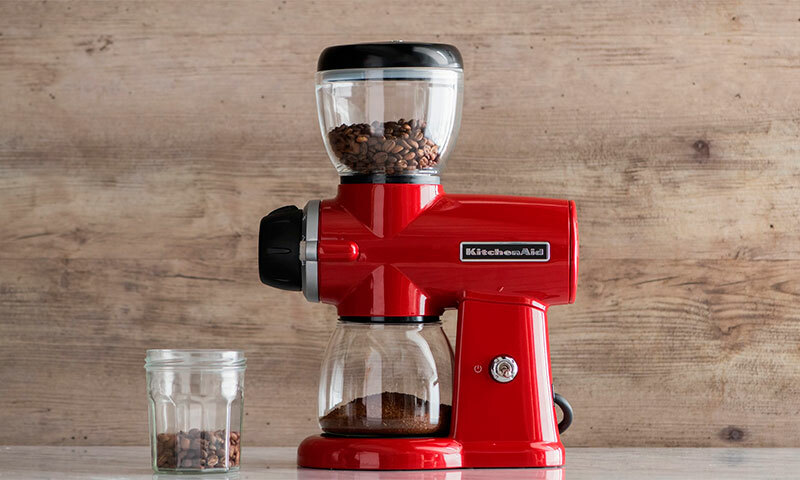According to statistics, every third person likes to drink coffee. The total number of such people has long exceeded the millionth value. Most of these connoisseurs belong to the category of connoisseurs who prefer to cook a delicious drink on their own. Shop counters are full of various coffee grinders. These are manual and electric types from a variety of manufacturers. It can sometimes be difficult to define oneself, because they differ from each other not only by type, design and price, but also by options, functional features, and numerous other parameters. Our guide of choice will help you not to be mistaken. Our experts have prepared detailed material that will tell not only about the varieties of coffee grinders, but also will reveal each parameter of those that are important when choosing in the first place.

Contents:
- The best companies producing coffee grinders
- Principle of operation and the device of coffee grinders
- Types of coffee grinders
- Options for the choice of the grinder
- Which grinder to choose
- How much is the grinder
The best coffee grinder manufacturers - which company to choose
Coffee grinders are produced by both small and large companies thatare engaged in the manufacture of various household appliances.
Inexpensive options from small firms usually do not cause consumer confidence, but the goods of world-famous giants are much more popular.
It is best to purchase coffee makers from niche companies that deal exclusively with this segment of the market.
We suggest that you familiarize yourself with the list of the most popular companies:
- Cunill;
- Macap;
- Delonghi;
- Gaggia;
- Krups.
These manufacturers offer a wide range of models, differing in performance and cost. Do not forget also that between household, semi-professional and professional devices there will be a big difference in almost all characteristics. For those who do not have the opportunity to get acquainted with the material to the fullest, we suggest immediately moving on to our rating of the best coffee grinders.
Principle of operation and the device of coffee grinders

1. The electric coffee grinder consists of two compartments, at the top there is a bowl for backfilling, and at the bottom there is an engine. After the grains are placed in a container, the lid is closed and the device is turned on. The grains are ground until the desired degree of grinding is achieved. Such devices are most often used at home. They do not provide the necessary uniformity.
2. Mill grinders are similar to classic manual grinders, they only work from the engine. The product also consists of two parts: one - for filling the grains, and the other - for the finished product. The grains from one compartment to another are routed through a millstone, which can be conical or plane-parallel. Conical consists of two cones inserted into each other, where only the lower one rotates.
3. Manual coffee grinders are almost identical to grinders, but all the work of grinding is due to the effort exerted by man. The upper compartment has a rotating handle, which starts the process of grinding the fried coffee beans.
Types of coffee grinders
Hand-held

A similar grinder grinds grain between special discs that can be made of metal or ceramics. The size between them can be adjusted depending on what grinding is needed, small or large. Disks are set in motion by a special handle, which resembles the handle of the meat grinder.
The grinding obtained after the hand grinder is not completely homogeneous, it has different fractions. For coffee in the east it just will not be suitable. Recently, such coffee grinders are rarely used, they are preferred to be used as decorations of the kitchen interior due to unusual design.
Advantages:
- low price;
- interesting design;
- no annoying noise.
Disadvantages:
- long time of grinding( not less than 15 minutes per serving);
- for fine grinding you need to put a lot of effort;
- slides on the table during the process.
Electric( rotary)

The rotary coffee maker is equipped with knives similar to a propeller. These sharp blades cut the coffee beans at a very high speed, turning them into powder. The degree of fineness of grinding will depend on the time of operation of the device: the longer, the correspondingly, the smaller and vice versa.
Although the homogeneity of grinding is not ideal for rotor machines, the resulting product can be used for cooking in a Turkish, geyser or drip coffee machine. Many connoisseurs of coffee criticize coffee grinders of this type, believing that the product must be grinded with millstones, and not thinned with knives.
Advantages:
- reasonable price;
- fast work;
- fine grinding.
Disadvantages:
- heterogeneity of the finished product;
- noise of electric drive;
- at high speed grinds coffee burns.
Electric( Millstone)

The grinder is the most convenient device, with an improved grinding process. Millstones, unlike knives, grind the product. It is better to choose a millstone not from steel, but from ceramics, as this material treats coffee more carefully, preserving its taste qualities.
Advantages:
- high speed;
- at a time will process up to 300 grams.grains;
- availability of electronic display;
- possibility to set the required degree of grinding;
- homogeneity and uniformity of grinding.
Disadvantages:
- high price;
- engine noise.
Parameters of the choice of a coffee grinder

Power
The high power of the device allows to cope with the task much faster than the low one. In the shops there are coffee grinders with a power from 100 to 300 W.The optimal option is the level from 150 to 200 watts.
Apparatuses with very high power are semi-professional and professional. Grains when crushed in such a coffee grinder can be charred, which will affect the taste of the drink, giving it bitterness.
Reliability
Rotary coffee grinders have swiveling knives, which increases the level of danger of the device. Manufacturers, in order to protect the user from getting injured, have made the locking system so that the knives can not start the rotation unless the lid is closed.
However, this method has its disadvantage: plastic fasteners that hold the lid are short-lived and quickly break. When choosing, pay special attention to them, because the stronger they are, the longer the coffee grinder will work.
See also the case material. Made of steel, brass or aluminum, it will last more time, but the plastic one will be less durable.
Overheating protection
This parameter is particularly important for models that have a power rating above 200W.The engine in such devices can overheat under prolonged operation. To prevent this from happening, a protective system must be activated, automatically turning off the coffee grinder until the critical heating level has subsided.
Running
The most common way to start rotary coffee grinders is from pressing the cover. This avoids accidental switching on the device, but it is not very convenient to use, since you have to hold the lid until the portion of the grains has shifted. There is also an option with a button, which presses the engine to start.
Availability of
Dispenser This option is very convenient, it is usually available in grinders with millstones. It allows you to completely fill up the grains with a capacity. To grind the device itself will take the right amount to grind. This will save you time, as it will not be necessary to refill the container each time.
Presence of timer and screen
In millstone types, screens are used, as we have already said, that allow you to display the necessary programs and grinding modes. Rotary coffee grinders instead of them usually either there is nothing, or there is a timer.
Models with a timer are much preferable, since once having calculated the optimal time for obtaining the desired fineness of the finished product, you only need to set this parameter to obtain the same result.
Noise level
All electric coffee grinders make noise. It appears because the grain is cut with knives or grinded with discs. Slightly reduce the noise level, removing unnecessary vibration, models of coffee grinders with legs of rubber.
Which coffee grinder to choose

1. If you do not hurry in the morning and you have a lot of free time, then a hand grinder will be just the right option. Anyone who wants to receive coffee powder quickly should choose electrical devices.
2. Rotary type machines produce more heterogeneous grinding than millstones, but are much cheaper.
3. Coffee makers for home use in power should be approximately 150 to 200 watts. Those who need semi-professional and professional devices, you need to pay attention to models with a power of more than 250 watts, but keep in mind that such devices need protection against overheating. But below 100 watts, it's better not to buy the devices, since they work very slowly.
4. The case of a coffee grinder is better to choose from metal, instead of plastic. Such products are much more durable. The internal elements grinding the fried grains are better than ceramic, because during the grinding process the product is not charred.
5. Prefer a rotary type coffee grinder with a timer, and a grinder coffee grinder - with a dispenser. In the first case, you do not need to follow the time each time to get the required grinding, it will be enough just to set the time. In the second - do not need to fill up the grains daily, since the device from the full container will take only the required amount.
How much does the coffee grinder

1. Hand grinders cost about 1 to 2 thousand p. There are cheaper options for 800-900 r, but they can not boast of good quality.
2. Prices for electric mill grinders start from 3 thousand r, but in shops it is very rare to find such cheap models. Usually the cost starts from 5-7 thousand rubles.
3. Rotary type coffee grinders are sold at 800-1 thousand rubles. Slightly more expensive, but also functional will cost 1.500-2 thousand rubles.
4. Models with ceramic elements and a steel body will be more expensive than plastic devices with metal elements for grinding.
5. Additional functions and options, for example, the presence of a dispenser, a timer and other things will affect the total cost. Such devices can be bought for about 2-7 thousand rubles, depending on the type of coffee grinder.



